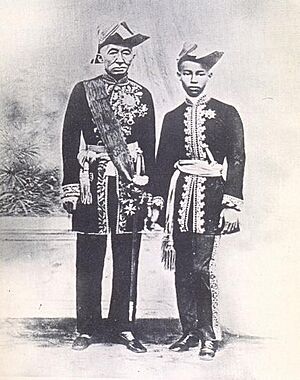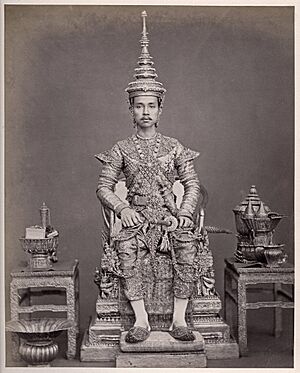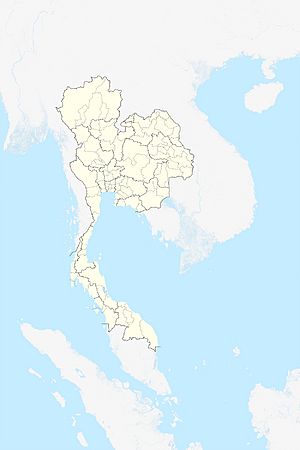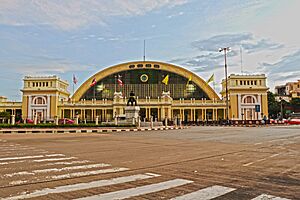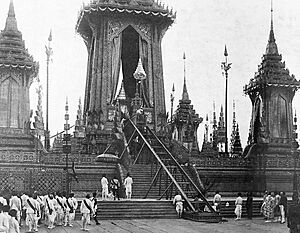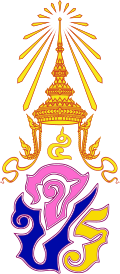Chulalongkorn facts for kids
Quick facts for kids Chulalongkornจุฬาลงกรณ์ |
|
|---|---|
| King Rama V | |
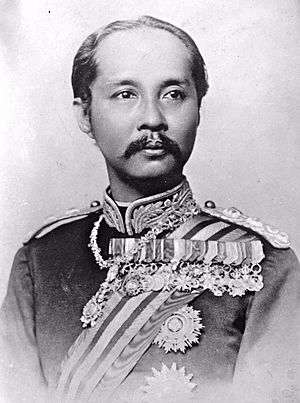
Chulalongkorn c. 1900s
|
|
| King of Siam | |
| Reign | 1 October 1868 – 23 October 1910 |
| Coronation | 11 November 1868 (1st) 16 November 1873 (2nd) |
| Predecessor | Mongkut (Rama IV) |
| Successor | Vajiravudh (Rama VI) |
| Regent | Si Suriyawongse (1868–1873) Saovabha Phongsri (1897) Vajiravudh (1907) |
| Viceroy | Bowon Wichaichan (1868–1885) |
| Born | 20 September 1853 Grand Palace, Bangkok, Siam |
| Died | 23 October 1910 (aged 57) Amphorn Sathan Residential Hall Dusit Palace, Bangkok, Siam |
| Spouse | Sunanda Kumariratana Sukumalmarsri Savang Vadhana Saovabha Phongsri and 5 other consorts and 143 concubines |
| Issue Detail |
32 sons and 44 daughters, including: Vajiravudh (Rama VI) Mahidol Adulyadej, Prince of Songkhla Prajadhipok (Rama VII) |
| House | Chakri |
| Father | Mongkut (Rama IV) |
| Mother | Ramphoei Sirivongse |
| Religion | Theravada |
| Signature | |
| Military career | |
| Allegiance | Siam |
| Service/ |
Royal Siamese Armed Forces |
| Years of service | 1868–1910 |
| Rank | Field marshal Admiral of the Fleet |
| Commands held | Royal Siamese Armed Forces |
Chulalongkorn (Thai: จุฬาลงกรณ์, born 20 September 1853 – died 23 October 1910) was the fifth king of Siam (now Thailand). He belonged to the House of Chakri and was known as Rama V. People in Siam at that time called him Phra Phuttha Chao Luang, which means "the Royal Buddha".
King Chulalongkorn's time as ruler was special because he brought many modern changes to Siam. He reformed the government and society. He also worked hard to keep Siam independent, even though it was surrounded by European colonies like the British and French. Because of his efforts to protect Siam's freedom, he earned the name Phra Piya Maharat, meaning "the Great Beloved King".
Contents
Early Life of King Chulalongkorn
King Chulalongkorn was born on 20 September 1853. His parents were King Mongkut (Rama IV) and Queen Debsirindra. He received a wide-ranging education, even learning from Western teachers like Anna Leonowens. In 1866, he became a novice monk for six months, following a royal tradition.
In 1867, his father, King Mongkut, went on a trip to the Malay Peninsula to observe a solar eclipse of 18 August 1868. Both the king and young Chulalongkorn became sick with malaria. King Mongkut passed away on 1 October 1868. Chulalongkorn was only 15 years old when he became king.
Si Suriyawongse, a very powerful government official, helped Chulalongkorn become king and became his regent (someone who rules for a young king). Chulalongkorn's first coronation was on 11 November 1868. As he got better, he learned more about how to run the country.
The young King Chulalongkorn was eager to make changes. He traveled to Singapore and Java in 1870, and then to British India in 1872. He wanted to learn how the British managed their colonies. These trips gave him many ideas for modernizing Siam. He had a second coronation and officially became king in his own right on 16 November 1873.
Early Years as King
After his regent, Si Suriyawongse, stepped down, King Chulalongkorn began to make his own decisions. He married four of his half-sisters: Savang Vadhana, Saovabha, Sunandha, and Sukumalmarsri.
One of his first big changes was creating the "Auditory Office" in 1873. This office was in charge of collecting all taxes. Before this, different noble families collected taxes, which gave them a lot of power and wealth. This new office helped the king gain more control over the country's money.
In 1874, King Chulalongkorn set up a Council of State to help make laws and a privy council to advise him. These councils were similar to those in Britain.
Front Palace Challenges
In 1874, a fire broke out near the main palace. Troops from the "Front Palace" (a powerful position, almost like a second king) arrived fully armed. This event showed how much power the nobles and royal relatives still had, which limited the king's own power. King Chulalongkorn wanted to reduce this power to truly reform Siam.
When Prince Yingyot, who held the Front Palace title, died in 1885, King Chulalongkorn used this chance to get rid of the Front Palace position. Instead, he created the title of "Crown Prince of Siam", like in Western countries. His son, Prince Vajirunhis, became the first Crown Prince.
Haw Insurgency
In the northern parts of Laos, near China, some Chinese rebels called Haw had become bandits. They were attacking villages. In 1875, King Chulalongkorn sent troops to stop them. The Haw were strong, but after more modern forces were sent in 1885, the Haw were defeated.
Military and Government Changes
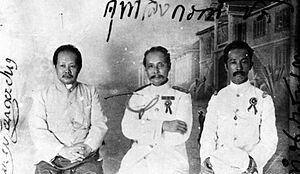
Once the challenges from the Front Palace and the Haw rebels were handled, King Chulalongkorn focused on modernizing Siam. He opened the Royal Military Academy in 1887 to train officers in a Western style. This helped him create a stronger, more centralized army.
Siam's government had been organized in the same way for centuries. In 1888, King Chulalongkorn began to create a system of ministries, similar to modern governments. By 1892, all ministries were established and had equal importance. Many of the first ministers were members of the royal family.
King Chulalongkorn also changed the justice system. He stopped the old methods of torture, which were seen as cruel, and brought in a Western legal system. His Belgian advisor, Rolin-Jaequemyns, helped a lot with these changes.
Calls for Reform
| Monarchs of the Chakri dynasty |
|
|---|---|
| Phra Buddha Yodfa Chulaloke (Rama I) |
|
| Phra Buddha Loetla Nabhalai (Rama II) |
|
| Nangklao (Rama III) |
|
| Mongkut (Rama IV) |
|
| Chulalongkorn (Rama V) |
|
| Vajiravudh (Rama VI) |
|
| Prajadhipok (Rama VII) |
|
| Ananda Mahidol (Rama VIII) |
|
| Bhumibol Adulyadej (Rama IX) |
|
| Vajiralongkorn (Rama X) |
|
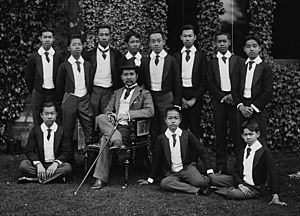
King Chulalongkorn was the first Siamese king to send royal princes to Europe for their education. In Europe, ideas about democracy and constitutional monarchies were popular. The princes learned about these ideas and were influenced by them.
In 1884, some Siamese officials in Europe suggested that Siam should become a constitutional monarchy, like Meiji Japan. They worried about European powers threatening Siam's independence. King Chulalongkorn felt it wasn't the right time for such a big change, but he continued to make his own reforms.
During his reign, new writers published their ideas, often criticizing traditional Siamese society. One important writer was Thianwan Wannapho.
Conflicts with French Indochina
In 1863, Cambodia was forced to become a French protectorate. Siam had to give up its claims over Cambodia in 1867. This was the first of many times Siam had to give up land.
In 1887, French Indochina was formed, including Vietnam and Cambodia. The French then wanted more land in Laos. In 1893, the French demanded all Laotian lands east of the Mekong River. Siam did not agree, which led to the Franco–Siamese War of 1893.
French warships entered the Chao Phraya River and threatened Bangkok. Fighting also happened in Laos. The French then sent an ultimatum: Siam had to pay a large sum of money and give up Laos. Siam did not accept at first. French troops then blocked the Gulf of Siam and occupied Chantaburi and Trat. King Chulalongkorn sent his advisor, Rolin-Jacquemyns, to negotiate. Siam eventually gave up Laos in 1893. However, French troops stayed in Chantaburi and Trat for another 10 years.
The loss of Laotian lands deeply affected King Chulalongkorn. He realized how important it was to have a strong navy and founded the Royal Thai Naval Academy in 1898.
In 1906, a final agreement was reached. Trat was returned to Siam, but the French kept some other areas.
To gain international recognition for Siam's independence, King Chulalongkorn visited Europe in 1897. He was the first Siamese king to do so. During his trip, he appointed his queen, Saovabha Phongsri, as regent to rule Siam.
Major Reforms in Siam
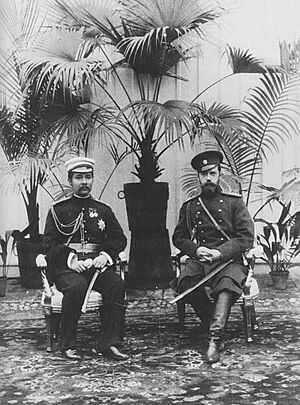
Before King Chulalongkorn, Siam was a network of cities that paid tribute to Bangkok. Each city had a lot of freedom. But with European colonialism, the idea of a "state" with clear borders became important. The conflict with the French in 1893 showed this clearly.
New Districts and Provinces
King Chulalongkorn created the first Sukhaphiban (sanitary districts) in Bangkok in 1897. He learned about these from England during his European trip and wanted to try them in his capital.
Following advice from Prince Damrong, King Chulalongkorn created the monthon system in 1897. This system organized the country into a clear hierarchy: monthon, then province, city, amphoe (district), tambon (sub-district), and muban (village). Each monthon was managed by an official from the Ministry of Interior. This system greatly increased the central government's power and ended the rule of local dynasties.
Some local rulers did not like losing their power, and there were a few rebellions in 1901. However, these were quickly put down in 1902, and the local rulers were removed from power.
Ending Forced Labor and Slavery
King Chulalongkorn is most famous for ending Siamese slavery in Siam. In the past, many common people were forced to work for the government or nobles for part of the year. This was called corvée. Also, many people became slaves if they couldn't pay their debts, or if their parents were slaves. By 1867, about one-third of Siam's population were slaves.
King Chulalongkorn wanted to end slavery peacefully, without a war like the American Civil War. In 1874, he passed a law that made it easier for household slaves born in 1867 to buy their freedom. They would be completely free when they turned 21. This gave them time to find jobs as farmers or merchants.
Finally, in 1905, the Slave Abolition Act completely ended all forms of slavery in Siam. To this day, the 100 baht banknote shows King Chulalongkorn in a navy uniform, symbolizing his abolition of slavery.
The old corvée system also changed. In 1900, the Employment Act made sure that all workers were paid for their labor, instead of being forced to work for free.
Modern Army and Land Ownership
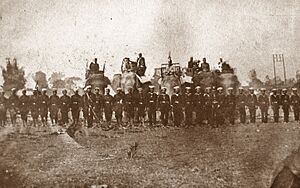
King Chulalongkorn created a defense ministry in 1887. With the end of forced labor, he introduced military conscription (requiring people to join the army) with the Conscription Act of 1905. This helped create a modern, professional army.
He also started the Royal Thai Survey Department to measure land. This helped define who owned which land, making it easier to register land and collect fair taxes. The first official land title deeds were issued in 1901.
Ending Prostration
In 1873, King Chulalongkorn made a big change to royal etiquette. He ended the practice of prostration, where people had to lie on the ground in front of important officials or the king. He said this practice was harsh and didn't benefit Siam. Instead, he allowed people to simply bow as a sign of respect.
Public Works and Infrastructure
King Chulalongkorn also focused on building new things for the country. He believed that building railways would connect all parts of Siam and help the government maintain control.
In 1901, the first railway line opened, connecting Bangkok to Korat. In the same year, Siam's first power plant started producing electricity, bringing electric lights to roadways for the first time.
Family
King Chulalongkorn had many children. He had 92 consorts (wives) during his life, and they had 77 children who survived.
Death and Lasting Impact

King Chulalongkorn visited Europe twice, in 1897 and 1907. During his first trip, he learned a lot about many subjects to help his people. He met many European royal families. He spent time in Britain and was inspired to improve public health in Siam. In Sweden, he studied forestry. In 1907, he visited his son's school in Britain and consulted doctors for his kidney disease.
King Chulalongkorn passed away on 23 October 1910, from kidney disease. He died at the Amphorn Sathan Residential Hall in the Dusit Palace. His son, Vajiravudh (King Rama VI), became the next king.
A large Equestrian statue of King Chulalongkorn was completed in 1908 to celebrate his 40th year as king. It was made in Paris.
Chulalongkorn University, Thailand's first university, was founded in 1917 and named in his honor. Statues of King Rama V and his son, Rama VI, stand on its campus.
In 1997, a special memorial pavilion was built in Ragunda, Sweden. This was to remember King Chulalongkorn's visit to Sweden in 1897. He traveled there to study forestry and left a lasting impression.
King Chulalongkorn is remembered as one of the "Most Influential Asians of the Century" by Time Asia Magazine in 1999. His reforms helped Siam become a modern nation and keep its independence during a challenging time.
Honours
| Styles of King Chulalongkorn Rama V of Siam |
|
|---|---|
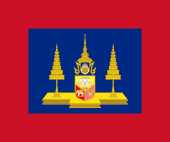 |
|
| Reference style | His Royal Majesty |
| Spoken style | Your Royal Majesty |
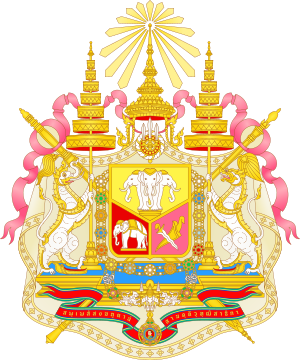
Military Ranks
- Field Marshal of the Royal Siamese Army
- Admiral of the Fleet of the Royal Siamese Navy
National Honours
- Founder and Sovereign of the Order of the Royal House of Chakri (1882)
- Sovereign Knight of the Ancient and Auspicious Order of the Nine Gems (1868)
- Founder and Sovereign of the Order of Chula Chom Klao (1900)
- Knight Grand Cordon of the Most Exalted Order of the White Elephant (1909)
- Knight Grand Cross of the Most Noble Order of the Crown of Thailand (1869)
- Dushdi Mala Medal Pin of Arts and Science (1882)
- Dushdi Mala Medal Pin the government in His Majesty (1882)
- Chakra Mala Medal (1882)
- King Mongkut's Royal Cypher Medal 1st Class (1904)
- King Chulalongkorn's Royal Cypher Medal 1st Class (1901)
- King Chulalongkorn's Rajaruchi Medal (1897)
Foreign Honours
- Grand Cross of the Order of St. Stephen of Hungary (Austria-Hungary) (1868)
- Grand Cross of the Royal and Distinguished Order of Charles III (Spain) (1871)
- Honorary Grand Cross of the Most Distinguished Order of St Michael and St George (United Kingdom) (1878)
- Grand Cross of the Royal Order of Kamehameha I (Kingdom of Hawaii) (1881)
- Grand Cross of the Royal Norwegian Order of Saint Olav (Sweden-Norway) (1884)
- Knight of the Royal Order of the Seraphim (Sweden-Norway) (1887)
- Grand Cordon of the Supreme Order of the Chrysanthemum (Empire of Japan) (1887)
- Knight of the Order of the Elephant (Denmark) (1892)
- Grand Cross of the Order of Saints Maurice and Lazarus (Kingdom of Italy) (1887)
- Knight of the Order of St. Andrew the Apostle the First-called (Russian Empire) (1891)
- Knight of the Supreme Order of the Most Holy Annunciation (Kingdom of Italy) (1891)
- Grand Cross of the Sash of the Three Orders (Kingdom of Portugal) (1897)
- Knight of the Order of the Black Eagle (Kingdom of Prussia) (1897)
- Knight of the Order of the Rue Crown (Kingdom of Saxony) (1897)
- Grand Cross of the Ludwig Order (Grand Duchy of Hesse) (1897)
- Knight of the House Order of Fidelity (Grand Duchy of Baden) (1897)
- Knight of the Order of Saint Hubert (Kingdom of Bavaria) (1906)
- Grand Cross of the Order of Henry the Lion (Duchy of Brunswick) (1907)
See also
 In Spanish: Chulalongkorn para niños
In Spanish: Chulalongkorn para niños
- List of children of Mongkut
- List of consorts and children of Chulalongkorn
- List of people with the most children
- King Ananda Mahidol
- King Bhumibol Adulyadej


